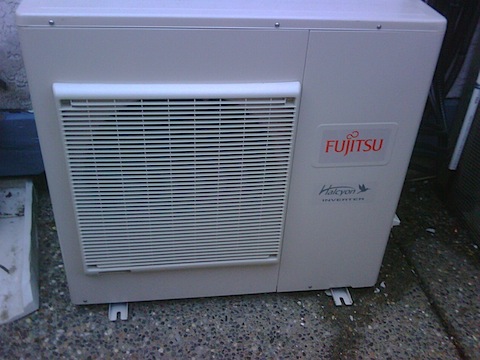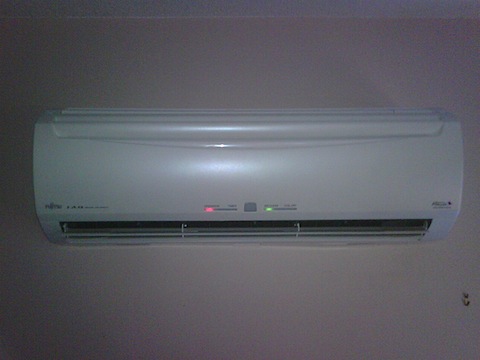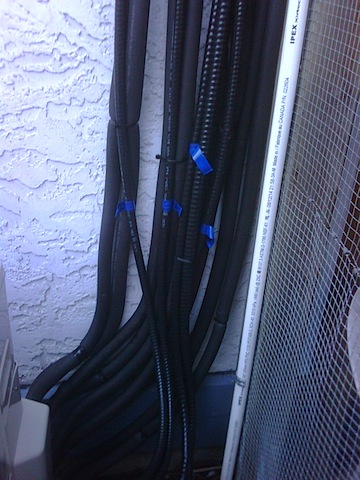Last week we had our air conditioning installed. Direct Heat was the company that did the work for us, and they installed a “ductless split” heat pump system from Fujitsu. It is 30 degrees celsius and 90% humidity outside, and about 20 degrees / 50% humidity inside. I’m pretty happy with the decision to install this system…
Ductless split air conditioning is a new concept for me, but apparently has been used commercially for years. Traditional “central” units hook into your furnace, and the cooled air is pushed around the house with your furnace’s ducting and fan system. Ductless split systems still have a central air conditioning unit, but instead of relying on the furnace, this system distributes cooling fluid to several units. Each room you want cooled is equipped with such a unit: basically, a fan system with cooling pipes running through it.
This is a good solution for homes that don’t have furnace ducts throughout. Our house has furnace ducts on the main floor, and radiant electric heat upstairs. Since two of the rooms we most wanted to cool (the bed room and our “exercise” room) are upstairs, this was a good option for us. Refitting our furnace to work house-wide would have also raised the price by 50% or more. As it was, the ductless split system for four rooms cost nearly $10,000 once electrical and cosmetic factors are considered.
I learned a lot in the process. The central unit for ductless split is essentially identical to the central unit used if you attach to a furnace. In both cases, refrigerant is pumped from the central unit: if you hook it to your furnace, that goes to one place (a unit that attaches to your furnace). With ductless split, it goes to how ever many places you have cooling “heads”: four in our case. Our central unit is a three “ton”, 15 SEER system. The SEER (seasonal energy efficiency ratio) value relates to energy efficiency, and a rating of 15 is “high efficiency”. A ton is 12,000 BTU, so that’s 36k BTU. Each head unit is 9k BTU, so it is a perfect match.
The central unit

One of our in-room units

The piping in ductless split is about half an inch diameter copper tubing wrapped in insulation, and the electrical for each in-room unit also comes from the central unit. This means a rather unattractive run of snakey pipe on the outside of our house. The “cosmetic” part I mentioned above is having these unattractive pipes clad in what basically amounts to gutter channels. According to our man from Direct Heat, Kurt, most people don’t install the conduit: I’m surprised by that, and told him so. We don’t have the “gutters” installed yet, so it isn’t pretty, but hopefully we’ll have it done shortly.
The currently-unclad piping at its worse (near the central system)
At the end of the day, the important thing is… can it cool a room down cold enough to make you feel chilled? The answer- yes. My office actually got cold enough yesterday that I almost reached for a sweater before I remembered it was air conditioning. Which leads to another benefit of ductless split: each room it is installed in can set its own temperature independently. So my office can be 22 degrees, my exercise room 19, and so on. These are also electrostatic air purifying units, which is nice as well.
As my Grandma used to say, I’m “living the life of Riley“… except no one is paying my bills except for myself 😉




You will find with that sort of system it is probably better to keep the rooms cool all the time – in other words, don’t turn everything off, let the house get to +30, then turn on all the air conditioning units all at once. One advantage with your system over a central system is that you can cool down rooms one at a time so as to stagger the load when you start with a hot house.
One of the disadvantages is that you can’t force the hot air out as a furnace blower might. You have to cool the air that’s in the room, not push it out and replace with fresh cool air.
And of course greater potential for leaks… but if they are running a glycol mix that should be good to – 40 you shouldn’t have to worry about freezing issues anyway 😉
The system also is different from most central air units in that it adjusts the speed/power consumption to load. That is: the central unit only runs at partial power if that’s all it needs, whereas standard units have two power levels- off and on. Another consideration is that it is a heat pump: in the winter it can be used to heat the rooms. I’ll be curious to see how that functions, but supposedly it works quite well in our climate.
The whole leak thing is an obvious concern: there are many yards of copper piping involved. One plus, I guess, to the way the pipe is run is that it is almost entirely on the outside of the house. If there is a leak of whatever magical chemical soup they use in air conditioning units these days, it will mostly vent/evaporate outside.
But right at the moment, with the temperature heading for the mid-30’s, worries of leaks or efficiency seem largely irrelevant. Wait until we get our first post-installation power bill, though!